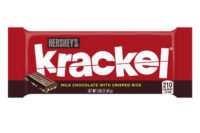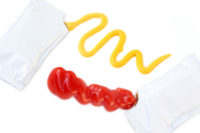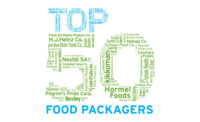Cover Story: Top 50 Food Packagers
Top 50 Food Packagers of 2014
The Best and the Brightest in Consumer Packaged Food.

|
Our Top 50 Food Packagers list uses sources that include annual company reports, news reports, company websites and direct company contacts.
Sales are based on calendar year 2013 or the most recent fiscal year that conforms to that timeframe. We used XE, the online currency counter (www.xe.com), where necessary. We have also drilled down to the best of our abilities using all available resources to separate out food revenue from beverages and other segment revenue.
*= estimate
**=2012 fi gure. 2013 fi gure not available
|
Welcome to our annual top 50 food packaging companies cover story. As explained further in the methodology box that correlates with the chart to right, Food and Beverage Packaging has ranked the top 50 food companies based on 2013 total revenues. As in the past, we organize the list in ranking order (starting with number one) by revenue in billions. We also highlight chief packaging officer of the company and a list of key brands. We have broken out revenue from beverage and other non-food product sales, when possible, so that we only include revenue from packaged food sales.
|
Previous Top 50 Food Packagers Articles |
The industry has had its ups and downs, but for the top three on our list, it was just ups. Nestlé has remained on top with $60.43 billion in revenue for 2013, that’s up from the reported $56.60 billion in 2012. PepsiCo remains in the number two position with $34.54 billion, up from $33.40 billion in 2012, while Tyson Foods is trailing very closely behind with $34.37 billion, up from the $33.30 billion reported in 2012.
To view the rankings, click here.
Food companies under pressure; packaging one solution
Source: Packaging Strategies, packstrat.com
What role does packaging play in increasing sales and profitability for America’s food companies? Food is the largest industry in the world, but some of the most notable players have acknowledged that 2013 was a challenging year.
“In the latest quarter food industry sales trends in the U.S. and Western Europe have been weak and we see that in our business too,” says Kendall J. Powell, General Mills chairman and CEO in a February presentation before the Consumer Analyst Group of New York.
Powell went on to say that “we don’t share the general pessimism” and that the company has some clear strategies for increasing its top line in 2014. General Mills reported 2013 sales of $17.77 billion, up 6.7% from the year before. Sales growth in 2012 was almost 12%.
But a similar sentiment was expressed by other companies. In the fourth-quarter conference call Mondeléz chairman and CEO Irene Rosenfeld says, “Frankly, we are very disappointed that our performance was below what we and our shareholders originally expected.”
Rosenfeld adds, “It turns out to be quite a challenging year as we faced slower category growth and volatility in some of our key markets.”
At Mondeléz, 2013 sales rose only 0.8% to $35.29 billion.
Kellogg reported lower-than-expected fourth-quarter sales (down 1.7% from the 2012 fourth quarter) due to continued weakness in cereal and some difficulties in the snack business. For the year, sales growth slowed in 2013, rising 4.2% to $14.79 billion; in 2012 sales were up 7.6%.
Analysts say the 2008 recession—both in the U.S. and Western Europe—dealt a blow from which food companies are still struggling to recover. The economic downturn limited opportunities for them to invest and manage assets in the faster-growing Asia-Pacific region. “The Eurozone recession particularly has affected the bottom line for many exporters,” says Frost & Sullivan food analyst Reuben Sequeira.
In addition, the global packaged food industry is finding it challenging to maintain and improve profitability due to factors such as price fluctuations for raw materials and energy, competition and a need to reduce the time taken to commercialize a new product.
Sequeira says that hedging with contracts, futures and options can reduce the risk associated with cost fluctuations. In addition, “It is important to stay ahead of the curve in consumer health and wellness knowledge, packaging technology and consumer needs and benefits that are well-known to the buyer but not recognized at the industry level.”
Packaging tactics
Using lower-cost, recyclable materials and reducing size and volume of packaging are some tactics food companies are turning to, continues Sequeira.
Chris Cornyn, president of Dine, a food marketing and branding company, says that often food companies try to boost sales with reformulating products, or exploring different sales channels. That can be very time-consuming, complicated and often the results can be questionable.
“A package redesign can increase returns almost immediately upon implementation,” says Cornyn. “It’s one of the most effective ways of improving a product.”
Today’s package needs to address a number of issues in the marketplace: it needs to draw attention, build the image, be instructive, educate, preserve, protect and contain. It needs to do so many things—things that can help sales,” Cornyn continues.
He added that today’s consumers are eating differently—snacking or on-the-go. They want convenient—but good—food. “Vending machines, convenience stores, are elevating their culinary offerings,” Cornyn says.
Cornyn, who spoke at the Best of Food and Beverage Packaging conference in April, is optimistic about the food business.
He looks forward to seeing how the packaging community can help on many levels—from the hipster juice company in Brooklyn developing a new beverage to the giant multinational grappling with how to refresh a 100-year-old brand.
Looking for a reprint of this article?
From high-res PDFs to custom plaques, order your copy today!








